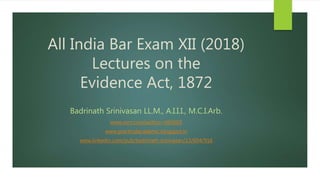Lecture 1: The Structure of Evidence Act, 1872
- 1. All India Bar Exam XII (2018) Lectures on the Evidence Act, 1872 Badrinath Srinivasan LL.M., A.I.I.I., M.C.I.Arb. www.ssrn.com/author=665603 www.practicalacademic.blogspot.in www.linkedin.com/pub/badrinath-srinivasan/13/604/916
- 2. Lecture 1 Structure of the Indian Evidence Act
- 3. AIBE and Evidence Law ’üĄ 8 questions carrying 8 marks ’üĄ Take the bare text for the exam: ’üĄ Relatively Small ’üĄ Not expensive ’üĄ Easy to carry ’üĄ A technical but important subject ’üĄ Understanding the structure of the Act is the most important thing ’üĄ Use AIBE as an opportunity to learn the basics of this important law ’üĄ Purpose of this lecture is not to teach but to aid students find the law ’üĄ BCIŌĆÖs reading material is sufficient for grasping the basics of Evidence law
- 4. Some Titbits about the Evidence Act ’üĄ Evidence law is procedural and not substantive law ’üĄ Common to civil and criminal proceedings but some provisions apply exclusively to civil or criminal proceedings, as the case may be: e.g., s. 52 (relevance of character in civil cases) and 116 & 117 (estoppel) while s 24-30 (confessions) apply to criminal law ’üĄ One of the widely admired pieces of legislation- regarded as abstract, technical and difficult to comprehend. ’üĄ general principle: All evidence must be excluded except when authorised under the Evidence Act. ’üĄ Sir James F Stephen, the principal architect of the law has relied considerably on the book, Taylor on Evidence, in drafting the Act.
- 5. Three Fundamental Rules & Parts of Evidence Law ’üĄ Three fundamental rules (JF Stephen, The Indian Evidence Act, 1873) ’üĄ Rule 1: Evidence must be confined to matters in issue ’üĄ Rule 2: Hearsay evidence is not to be admitted ’üĄ Rule 3: ŌĆ£Best evidence RuleŌĆØ: In all cases the best evidence must be given ’üĄ Evidence Act is divided into 3 parts based on the below three-fold classification ’üĄ Relevance of facts- s. 1-55 ’üĄ Proof of facts- s. 56-100 ’üĄ Production of proof of relevant facts- 101 to 167
- 6. Parts of the Evidence Act (1) ’üĄ Part I: Relevancy of Facts ’üĄ Preliminary aspects (s. 1-4) ’üĄ Facts that are relevant and not relevant (s. 5-55) ’üĄ Part II: On Proof ’üĄ Facts that need not be proved (s. 56-58 ’üĄ Oral evidence (s. 59-60) ’üĄ Documentary evidence (s. 61-90A) ’üĄ Exclusion of oral by documentary evidence (s. 91-100)
- 7. Parts of the Evidence Act (2) ’üĄ Part III: Production and Effect of Evidence ’üĄ Burden of proof (s. 101-114A) ’üĄ Estoppel (s. 115-117) ’üĄ Witnesses (s. 118-134) ’üĄ Examination of witnesses (s. 135-166) ’üĄ Improper admission and rejection of evidence (s. 167)
- 8. Charts in the Bare text of the Act ’üĄ Charts at the preliminary pages of the draft are sufficient to understand the structure of the Act. ’üĄ Chart I: Structure of Evidence Act ’üĄ Chart II: Relevance of Facts ’üĄ Chart III: Proof ’üĄ Chart IV: Production and Effect of Evidence https://goo.gl/ZvqZCL









